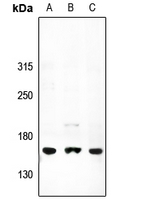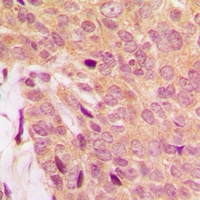Anti-ATP7A Antibody
- 产品详情
- 实验流程
- 背景知识
Application
| WB |
|---|---|
| Primary Accession | Q04656 |
| Reactivity | Human, Mouse, Rat |
| Host | Rabbit |
| Clonality | Polyclonal |
| Calculated MW | 163373 Da |
| Gene ID | 538 |
|---|---|
| Other Names | MC1; MNK; Copper-transporting ATPase 1; Copper pump 1; Menkes disease-associated protein |
| Target/Specificity | KLH-conjugated synthetic peptide encompassing a sequence within the center region of human ATP7A. The exact sequence is proprietary. |
| Dilution | WB~~1/500 - 1/1000 |
| Format | Liquid in 0.42% Potassium phosphate, 0.87% Sodium chloride, pH 7.3, 30% glycerol, and 0.09% (W/V) sodium azide. |
| Storage | Store at -20 °C.Stable for 12 months from date of receipt |
| Name | ATP7A {ECO:0000303|PubMed:28389643, ECO:0000312|HGNC:HGNC:869} |
|---|---|
| Function | ATP-driven copper (Cu(+)) ion pump that plays an important role in intracellular copper ion homeostasis (PubMed:10419525, PubMed:11092760, PubMed:28389643). Within a catalytic cycle, acquires Cu(+) ion from donor protein on the cytoplasmic side of the membrane and delivers it to acceptor protein on the lumenal side. The transfer of Cu(+) ion across the membrane is coupled to ATP hydrolysis and is associated with a transient phosphorylation that shifts the pump conformation from inward-facing to outward-facing state (PubMed:10419525, PubMed:19453293, PubMed:19917612, PubMed:28389643, PubMed:31283225). Under physiological conditions, at low cytosolic copper concentration, it is localized at the trans-Golgi network (TGN) where it transfers Cu(+) ions to cuproenzymes of the secretory pathway (PubMed:11092760, PubMed:28389643). Upon elevated cytosolic copper concentrations, it relocalizes to the plasma membrane where it is responsible for the export of excess Cu(+) ions (PubMed:10419525, PubMed:28389643). May play a dual role in neuron function and survival by regulating cooper efflux and neuronal transmission at the synapse as well as by supplying Cu(+) ions to enzymes such as PAM, TYR and SOD3 (By similarity) (PubMed:28389643). In the melanosomes of pigmented cells, provides copper cofactor to TYR to form an active TYR holoenzyme for melanin biosynthesis (By similarity). |
| Cellular Location | Golgi apparatus, trans-Golgi network membrane; Multi-pass membrane protein. Cell membrane; Multi-pass membrane protein Melanosome membrane {ECO:0000250|UniProtKB:Q64430}; Multi-pass membrane protein. Early endosome membrane {ECO:0000250|UniProtKB:Q64430}; Multi-pass membrane protein. Cell projection, axon {ECO:0000250|UniProtKB:P70705} Cell projection, dendrite {ECO:0000250|UniProtKB:P70705}. Postsynaptic density {ECO:0000250|UniProtKB:P70705}. Note=Cycles constitutively between the TGN and the plasma membrane (PubMed:9147644). Predominantly found in the TGN and relocalized to the plasma membrane in response to elevated copper levels. Targeting into melanosomes is regulated by BLOC-1 complex (By similarity). In response to glutamate, translocates to neuron processes with a minor fraction at extrasynaptic sites (By similarity). {ECO:0000250|UniProtKB:P70705, ECO:0000250|UniProtKB:Q64430, ECO:0000269|PubMed:9147644} [Isoform 5]: Endoplasmic reticulum |
| Tissue Location | Widely expressed including in heart, brain, lung, muscle, kidney, pancreas, and to a lesser extent placenta (PubMed:8490646, PubMed:8490659). Expressed in fibroblasts, aortic smooth muscle cells, aortic endothelial cells and umbilical vein endothelial cells (at protein level) (PubMed:16371425) |
Research Areas
For Research Use Only. Not For Use In Diagnostic Procedures.
Application Protocols
Provided below are standard protocols that you may find useful for product applications.
BACKGROUND
Rabbit polyclonal antibody to ATP7A
终于等到您。ABCEPTA(百远生物)抗体产品。
点击下方“我要评价 ”按钮提交您的反馈信息,您的反馈和评价是我们最宝贵的财富之一,
我们将在1-3个工作日内处理您的反馈信息。
如有疑问,联系:0512-88856768 tech-china@abcepta.com.
¥ 1,500.00
Cat# AP54130























 癌症的基本特征包括细胞增殖、血管生成、迁移、凋亡逃避机制和细胞永生等。找到癌症发生过程中这些通路的关键标记物和对应的抗体用于检测至关重要。
癌症的基本特征包括细胞增殖、血管生成、迁移、凋亡逃避机制和细胞永生等。找到癌症发生过程中这些通路的关键标记物和对应的抗体用于检测至关重要。 为您推荐一个泛素化位点预测神器——泛素化分析工具,可以为您的蛋白的泛素化位点作出预测和评分。
为您推荐一个泛素化位点预测神器——泛素化分析工具,可以为您的蛋白的泛素化位点作出预测和评分。 细胞自噬受体图形绘图工具为你的蛋白的细胞受体结合位点作出预测和评分,识别结合到自噬通路中的蛋白是非常重要的,便于让我们理解自噬在正常生理、病理过程中的作用,如发育、细胞分化、神经退化性疾病、压力条件下、感染和癌症。
细胞自噬受体图形绘图工具为你的蛋白的细胞受体结合位点作出预测和评分,识别结合到自噬通路中的蛋白是非常重要的,便于让我们理解自噬在正常生理、病理过程中的作用,如发育、细胞分化、神经退化性疾病、压力条件下、感染和癌症。







